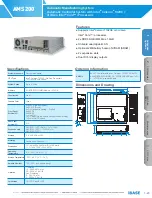
ULB PROPRIETARY RIGHTS NOTICE
- This document contains the confidential and proprietary information of ULB. You may not possess,
use, copy or disclose this document or any information in it for any purpose without express written permission. Neither receipt from any source,
nor possession of this document, constitutes such permission. Possession, use, copying or disclosure by anyone without express written
permission of ULB is not authorized and may result in criminal and/or civil liability.
U:\ILB\5_Technical Manual\TLB-R1000-480-OS_NO ALL\TLB-R1000_480_MANUAL_Rev03.docx
Page
10
of
35
Operation
Load Power Connection
Connect the power source under test to main input load bus bars and size the load cable per
the NEC (National Electric Code) or any local codes. Correctly sized copper compression lugs
are recommended.
The Load Bank has three main input load bus bars (marked L1, L2, and L3). Load cable
connections are made directly to the respective bus bars which have provisions provided for
suitable mounting.
Load cable conductors from the power source to the load bank should be adequately sized
and protected to handle the maximum rated load, and in accordance to the
National Electric
Code and any local codes
.
-Turn on the power source under test.
Display (E1A) will turn on.
Verify – Check Emergency Stop Button (E2A) is in the “Released (Depressed)” operating
position.
Press green button on Power On/Off Switch (E3A) and orange lamp will illuminate to show that
control power is on.
Verify that Load Dump switch (E4A) is in OFF (Down ward) Position.
Use main screen on HMI display (as shown below Fig.1) to set require KW.
Fig.1 Main Screen











































